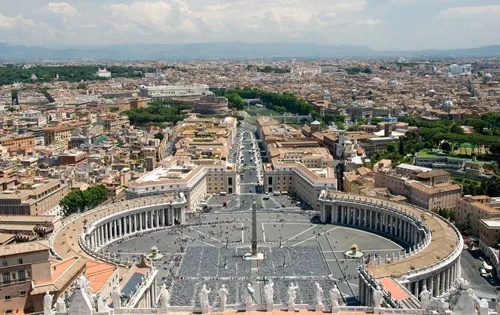
St. Peter's Square. Credit: Camille King (CC BY-SA 2.0).
Vatican City, Oct 21, 2013 / 02:12 pm (CNA/EWTN News).-
As Vatican City commits to financial transparency, the hiring of a risk-management company to review the Administration of the Patrimony of the Apostolic See may reveal differing opinions about financial reform.
The Administration of the Patrimony of the Apostolic See – APSA – is the office that handles the Vatican’s investment portfolio and its real estate holdings, as well as serving as the Vatican employment office and procurements agency.
APSA announced Oct. 15 that a “due diligence” review by the Promontory Financial Group had begun. Promontory had already been hired to review all the accounts and the procedures of the Institute for Religious Works, the so-called 'Vatican bank'.
Due diligence is the “evaluation of risks” in investments and loans, particularly with regards to the clients in a bank.
However, APSA is not a bank. The Holy See told evaluators from Moneyval, the European Council committee that evaluates adherence to anti-money laundering standards, that while APSA holds some accounts, such banking-type activity is minimal and will be closed.
In a July report on Vatican City, Moneyval wrote that “the APSA representatives stated that in 2001 the Board of Cardinals took the decision to gradually limit the provision of financial services to individual persons (both clerical and lay) that are not organs or bodies of the Holy See/Vatican City State.”
“Finally,” the report continued, “on 27 January 2006, the Board of Cardinals decided to start the process of closing all remaining accounts with those persons as far as possible (copies of the minutes recording these decisions were shown to the evaluation team).”
According to Moneyval's report, the representatives of APSA also “stressed that since 2001 no deposits have been accepted for the remaining 23 accounts of natural persons. APSA only managed the assets deposited within those accounts and only the yields of the assets managed were reinvested.”
The 23 accounts belong to 15 cardinals and bishops who deposited charitable contributions made on their behalf, with the proceeds going to the Vatican or their home dioceses; and eight laypeople who made large donations, particularly of property, to the Vatican, and were receiving annuities until their deaths.
A source who wanted to maintain anonymity shared with CNA Oct. 18 that “starting this kind of due diligence procedures could create a split between decisions on APSA and the Vatican overall strategy to adhere to international anti-money laundering standards.”
The Holy See is due to issue a progress report on its adherence to anti-money laundering standards at the next Moneyval plenary assembly, to be held Dec. 9-13.
The APSA-related policy could in some ways influence the Moneyval evaluation because “while the Holy See explained that the Administration is not a bank and has not a bank's activity, it started due diligence, which can easily be referred to a banking activity,” according to the source.
But if there is not banking activity, the source asked, “will due diligence be applied to the functioning of the dicastery? And will this be a precedent to apply due diligence to each Vatican office?”
Another question the source raised the question of whether “it is proper to exalt the role of external companies, like Promontory Financial Group, in addition to backing the overall reform of the Vatican financial system begun under the Benedict XVI’s pontificate?”
The source's words seem to reveal a variety of views within the Vatican walls regarding the carrying out of the reform of Vatican finances.
APSA also announced Oct. 15 that in response to recommendations made by the Council of Cardinals for the Study of the Organizational and Economic Problems of the Holy See, it was creating a supervisory board, but did not say what the responsibilities or power of the board would be.
Another source familiar with Vatican finances told CNA Oct. 20 that “there is seemingly an idea to apply to the Holy See, rules and procedures that are usually applied to big international companies.”
This strategy, he said, “does not take in consideration the peculiarity of the Vatican City State, which had been until now building a customized financial model, adherent to international standards and at the same times shaped in order to preserve the sovereignty of Vatican City State.”
Despite what is often reported, Vatican City State has no banks and no financial market.
The new model of financial system was further shaped by an Aug. 8 motu proprio which established a Committee for Financial Security, and by the Oct. 9 confirmation of Law XVIII, which implemented the Holy See's anti-money laundering measures.
Tags:
Administration of the Patrimony of the Apostolic S, APSA
Ads by AdsLiveMedia.com
Source:
http://www.catholicnewsagency.com/news/vatican-finance-reform-shows-different-opinions-about-process/Tags:
9news nfl Julius Thomas Jameis Winston Low Winter Sun






